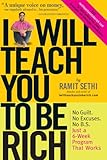 I Will Teach You to be Rich
I Will Teach You to be Rich
By: Ramit Sethi
I’ve been a reader of Ramit’s blog (iwillteachyoutoberich.com) for several years now, so when I heard that he was writing a book (and publishing one) I knew it would have to find a way onto my list of books to read. Which it did, and I did read it.
If you aren’t familiar with Ramit’s writing style, it’s some what irreverent. Light and joking, it’s as if he were talking to you over a beer. Which, of course, works pretty well for a book that is meant to be read by a twenty-something single person. There’s a reason it’s on the New York Times Bestseller list!
Ramit takes you through a 9 chapter, 6 week journey of personal finance. He covers everything from credit cards, savings and checkings, investing, budgeting, and saving for goals. For the person who finds themselves fresh out of high school or college and overwhelmed by the amount of credit offers and spending temptations, this book is a must read. Ramit did a very good job of pointing out and explaining some of the very common pitfalls of personal finance, and he does it in a way that makes sense.
There were only a few things that I found I disagreed with. The biggest of these was what he calls Conscious spending. As he describes it, it is the act of consciously setting limits and goals for spending so that you don’t overspend. Where I disagree is when he says that it isn’t a budget. It certainly sounds like one to me. While it may not be a budget that accounts for every penny and every category, it still is a budget. Maybe I’m giving budgeting too broad of a description, but to me any ordered system that sets limits and goals for spending and saving is a budget. What conscious spending is, is a very high level budget.
Anyone who has read this site for very long will know that I am not a fan of credit cards. I’m not really a fan of debt at all, but credit cards (to me) are one of the worst offenders. So, it was with some trepidation that I began the chapter on credit cards. It was somewhat refreshing to have someone actually explain how they use cards, and why. Because of my stance on credit cards, however, I couldn’t help but disagree with several points.
Overall, this is a spectacular book for it’s intended audience. Seasoned personal finance students will surely find a few nuggets, but the rest is likely review. If you know anyone that is just stepping out on their own personal finance journey, I suggest you get them this book. Ramit does an excellent job of laying out a wonderful foundation for successful personal finance management. And, yes, it may even teach you to be rich.
You can pick “I will teach you to be rich” up at Amazon, or just about any corner bookstore. As of this writing, the book is less than $11 at Amazon, which is likely better than you’ll see it anywhere else.

I started this blog to share what I know and what I was learning about personal finance. Along the way I’ve met and found many blogging friends. Please feel free to connect with me on the Beating Broke accounts: Twitter and Facebook.
You can also connect with me personally at Novelnaut, Thatedeguy, Shane Ede, and my personal Twitter.

Leave a Reply